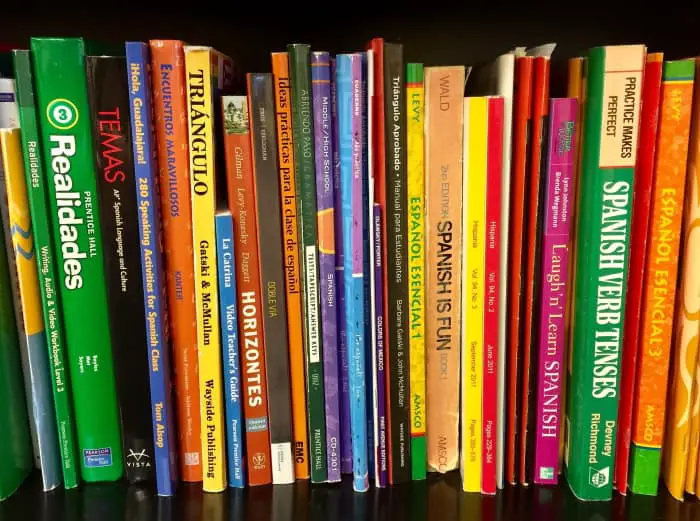There are so many reasons to develop your language skills. Learning a new language may be difficult. However, it is not impossible, especially if you are taking a Spanish class. Are Spanish classes worth it, then?
Spanish classes are worth it. A Spanish class gives a strong ROI as it makes someone more qualified and easily hirable. Spanish classes will not only improve language skills using expert guidance, but they give a concrete setting and routine that increases the chances to attain goals.
As an EL teacher in public schools for many years, plus from our own language learning experience with learning a second language, I’ve been able to really look at the pros and cons, including a cost-analysis, that’s involved. In this post, we will discuss the various ways why a Spanish class is worth investing your time, money, and effort for yourself, and/or your children.

Contents
Why Should You Take A Spanish Class?
Taking a language course in Spanish is highly worth your time, money, and effort. These classes provide you with unmatched experience and cover a variety of modalities in language learning. From writing to reading to speaking the language, Spanish classes offer you expert knowledge and language learning understanding you can’t get from an app or by simply doing your own online training.
For example, the following chart highlights a list of advantages and disadvantages of taking Spanish classes:
| Advantages to Spanish Classes | Disadvantages to Spanish Classes |
| -Learning about the history of Spanish culture -The traditional setting appeals to many. -Proper grammar is taught in a classroom setting. -You will learn how to both write and speak the language, as many apps only focus on speaking a language. -An emphasis on all 4 language domains: reading, writing, speaking, and listening -Proper practice with other people at varying levels of understanding -The curriculum work is done for you | -It may be costly depending on the school. -It may be time-consuming or time constraining depending on the course offerings and your schedule. -Classes aren’t tailored specifically to your needs. –Teacher to student ratio is not always optimal. -Conversational language might be limited. -Not as convenient as learning apps or 1:1 lessons -The traditional setting can lack creativity. |
As you can see, the advantages and disadvantages are there on both sides, so it’s important to look at everything. What might matter more to one person, might be less important to someone else.
But when you weigh both sides, you may actually see that the disadvantages of learning in a traditional classroom setting aren’t even that big of a deal. And this then serves as evidence of why traditional classroom learning might be best for you (or your loved one).
Let’s look more closely at some of the reasons that make taking a Spanish class worth it:
- You become instantly more qualified for most jobs.
- You increase your brain’s elasticity by challenging it to learn new information. (To learn more about the effect of language learning on the brain, check out this other article I wrote titled: This is How Language Learning Affects the Brain)
- Allows you to converse with native Spanish speakers when traveling.
- Expands your world of art and literature to include Spanish novels, poetry, artwork, and so on.
- Spanish classes provide you with language partners, as well as an expert guide for support.
Not only does Spanish make for improved marketability if you are on the job market, but it can be a fun learning experience, too. By taking Spanish classes, you will be able to enter a community of learning-minded individuals. You will be able to draw on their support as you tackle the difficulties of verb conjugation and draw on your conversational skills.
As you grow older, you’ll also see more of a benefit from using a traditional classroom setting such as camaraderie, organization, expertise, all-in-one convenience, and more! These features aren’t always common in the adult world and as such, are much more recognized as valuable!
Here are some other articles I recommend that are related to Spanish classes, or learning Spanish:
- Is Spanish Fun to Learn? (Solved!)
- 21 Tips When Learning Spanish
- Will Spanish Replace English In The USA? (Surprising Answer)
- 16 Ways Learning Spanish Can Benefit You
Are Spanish Classes Worth the Effort?
Spanish classes are worth the effort because it expands your universe on a personal level, and the potential to increase your professional resume is heightened, too. By learning Spanish, you can converse with people who may only speak Spanish. And you may be able to apply your new Spanish language skills to other Latin-derived languages.
Professionally, you’ll be able to open doors that require Spanish-speaking.
Simply put, research supports the effort involved in learning Spanish because of the following:
- Easier to learn other languages
- Ability to talk with new people
- An easier time when traveling in a Spanish-speaking country
Overall, putting in the effort to learn Spanish will open your eyes to new ideas, new perspectives, and new understandings. Studying Spanish is by no means easy, but if you are dedicated, it can only improve your life!
Are Spanish Classes Worth the Time?
Most people can expect to learn a language in 575 to 2200 hours, which is highly variable depending on the individual and the targeted language. And that is a lot of time to spend learning a language, so you may be asking if learning Spanish is worth all that time!
Based on a study done by the Foreign Service Institute of the United States, for learning Spanish as a native English speaker, it is estimated to take about 600 hours to become proficient. This breaks down to about six months if you are a diligent learner practicing weekly.
But there are quite a few factors that impact the amount of time it takes one person to learn a language, including the following:
- Prior learning experiences – If you were taught language formally in school, your ability to learn Spanish through courses later in life is easier than people without prior language learning.
- A supportive environment – If you are learning in an environment where the instructor is invested in your success and demonstrates that commitment through being authentic and creative, your ability to learn Spanish is improved.
- Ability to practice conversation – An in-class approach to verbal communication makes a big difference because it forces you to use your Spanish knowledge frequently and not simply regurgitate information but apply your Spanish skills.
- Your native language– Learning a language similar to your native language or mother tongue is simpler. For instance, Spanish is considered a Romance language. This means it is related to other Romance languages: French, Italian, Portuguese, and Romanian. If you come from one of these backgrounds, it will be easier than if you speak German, Korean, or Japanese, for example.
- Your Immersion Ability– Immersion is the best way to learn a language. Short of moving to a Spanish-speaking country, it will be easier to learn Spanish if you live in a place where there are many Spanish-speaking communities such as a large city or enclave with many Spanish speakers.
By having all these factors incorporated into your Spanish class or as part of your prior knowledge, you are more likely to become proficient at a rate that is faster than peers who may not have access to the same opportunities.
It’s not impossible to create a Spanish-language learning environment that checks all these bullets from the list, but it’s certainly easier to do with a Spanish class.
In all, Spanish classes are worth it because, as the Foreign Service Institute has studied, nothing can shorten the amount of time necessary to learn a language. If you want to learn the language with proficiency, you will have to dedicate time to learning. And the more time you spend actually learning Spanish rather than piecemealing a curriculum for yourself, the faster you can achieve proficiency.
Are Spanish Classes Worth the Expense?

Depending on where you sign up for Spanish classes, a class or program’s cost can fluctuate drastically. Larger cities have more opportunities than smaller ones, for example, and that generally means lower cost to the consumer.
And based on personal experience, both as a tutor and as someone paying a tutor, you can expect to pay a dollar a minute for Spanish lessons from a one-on-one teacher. That’s mucho dinero!
However, if you are looking for a traditional class (meaning a setting with more than just yourself and an instructor), you can try a variety of less expensive options. The following are places to sign up for Spanish classes:
- The nearest community or state college
- A local community center
- Language exchange programs
- University extension programs
- Local library
- Religious facility, particularly in the Catholic denomination
- Public high school
In the following chart, we break down the potential costs of learning Spanish using different modes of instruction:
| Type of Instruction | Average Cost |
| One-on-one language lessons | $30 for half hour; $60 for full hour lesson |
| Group classes | $100 to $150 per non-credited course; college credit course are higher |
| Online programs | Free to $450 |
| Language immersion | $1,000 to $8,000 |
| Local library/church | *Potentially Free* Keep in mind that the quality varies greatly with free programs. |
As you can see, Spanish classes are a relatively inexpensive choice, especially when compared to the more intensive modes of instruction like language immersion or 1:1 tutoring. While immersion, and even 1:1 tutoring, will most likely have you learning Spanish much faster, the costs of those options are also the most expensive for learning a new language.
As a bonus, you may be able to find less expensive or even free classes at a volunteer-run community center or by joining a Spanish club if you are in school. Don’t be afraid to call up area rec centers, libraries, and churches to ask what’s available!
Alternatives to Sitting In Class To Learn Spanish
If the thought of sitting in a classroom makes you want to pull your hair out or you happen to live in an area where traditional Spanish classes aren’t available to you conveniently, there are alternatives ways that you can learn Spanish. The following are additional ways you can learn Spanish that is not through the traditional classroom setting:
- Phone applications – Like Babbel, Duolingo, or iTalki
- Online resources – For example, Rocket Languages and FluentU
- Radio and podcast shows – Like News In Slow Spanish and other shows focused solely on the Spanish language
- Courses– Rosetta Stone (Amazon) is one of the first video/DVD/Computer language-learning courses
However, without an instructor-led class structure, it may take you much longer to learn Spanish if you do not have a rigid schedule for learning. It is definitely harder to maintain your motivation for learning a new skill like a language if you don’t have a routine to count on.
In Summary: Spanish Classes Are Worth It!
By now, we have hopefully convinced you that taking a Spanish class will be worth your time, money, and effort. Not only will learning a new language improve your brain’s health, but it will also improve your life overall.
Though modern technology has certainly made learning a language in a non-traditional way more accessible, it’s not always the best method for everyone. Often times, the traditional classroom is the most cost-effective way to get the support and routine you need. After all, there’s a reason classes are still used today by millions of people, despite the invention of computers and smart phones.
With your newly learned Spanish, you can converse with new people and explore Spanish culture with a new perspective and deeper understanding, as well as expand your job potential! So go ahead and sign up for Spanish classes today! Vamonos!
Once again, here are some other Spanish-related articles I highly recommend:
- Is Spanish Fun to Learn? (Solved!)
- 21 Tips When Learning Spanish
- Will Spanish Replace English In The USA? (Surprising Answer)
- 16 Ways Learning Spanish Can Benefit You
Other Sources:
